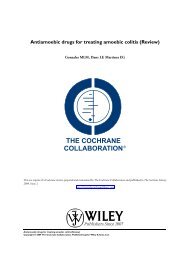Artemisinin-based combination therapy for ... - The Cochrane Library
Artemisinin-based combination therapy for ... - The Cochrane Library
Artemisinin-based combination therapy for ... - The Cochrane Library
You also want an ePaper? Increase the reach of your titles
YUMPU automatically turns print PDFs into web optimized ePapers that Google loves.
Bukirwa 2005 UGA (Continued)<br />
Adequate sequence generation? Yes ’An off-site investigator prepared computer-generated<br />
age-stratified randomisation<br />
codes’<br />
Allocation concealment? Yes ’<strong>The</strong> randomisation list was secured in a<br />
locked cabinet accessible only by the study<br />
nurse. Participants were enrolled by study<br />
physicians and treatments were assigned by<br />
the study nurse’<br />
Blinding?<br />
All outcomes<br />
Incomplete outcome data addressed?<br />
All outcomes<br />
Yes ’Only the study nurse was aware of treatment<br />
assignments. All other study personnel<br />
including study physicians and laboratory<br />
personnel involved in assessing outcomes<br />
were blinded’<br />
Yes Participants were excluded be<strong>for</strong>e enrolment<br />
only by predefined criteria. Losses to<br />
follow up after enrolment were low (1%<br />
AL6 vs 1.5% AS+AQ)<br />
Free of selective reporting? Yes <strong>The</strong> WHO recommends 42 days follow up<br />
in studies of AL6. Day 28 outcomes may<br />
under estimate treatment failure with AL6.<br />
Free of other bias? Yes No other sources of bias identified<br />
Djimde 2004 MLI<br />
Methods Trial design: A single blind (outcome assessors) randomized controlled trial<br />
Follow up: Days 0, 1, 2, 3, 7, 14, 21, and 28 or any other day they became ill, <strong>for</strong> a<br />
clinical assessment and malaria film<br />
Adverse event monitoring: Haemoglobin, glucose, complete blood count, liver enzymes,<br />
and creatinine were measured on days 0, 7, 14, and 28<br />
Participants Number: 502 randomized to included treatment arms<br />
Inclusion criteria: Age > 6 months, weight > 5 kg, axillary temp > 37.5 ºC, uncomplicated<br />
malaria of any species 2000 to 200,000/µl, able to tolerate oral treatment, resident of<br />
study area <strong>for</strong> entire period of follow up, in<strong>for</strong>med consent<br />
Exclusion criteria: Pregnancy, symptoms of severe malaria, allergy to a study drug, documented<br />
consumption of 1 of the study drugs in the previous 7 days<br />
Interventions 1. Artesunate plus amodiaquine, fixed dose <strong>combination</strong>, 50/153 mg tablets (Arsucam:<br />
Sanofi-Aventis)<br />
• AS 4 mg/kg once daily <strong>for</strong> 3 days<br />
• AQ 10 mg/kg once daily <strong>for</strong> 3 days<br />
2. Artesunate plus sulfadoxine-pyrimethamine, loose <strong>combination</strong> (Arsumax: Sanofi-<br />
Aventis, Fansidar: Roche)<br />
<strong>Artemisinin</strong>-<strong>based</strong> <strong>combination</strong> <strong>therapy</strong> <strong>for</strong> treating uncomplicated malaria (Review)<br />
Copyright © 2009 <strong>The</strong> <strong>Cochrane</strong> Collaboration. Published by John Wiley & Sons, Ltd.<br />
48








